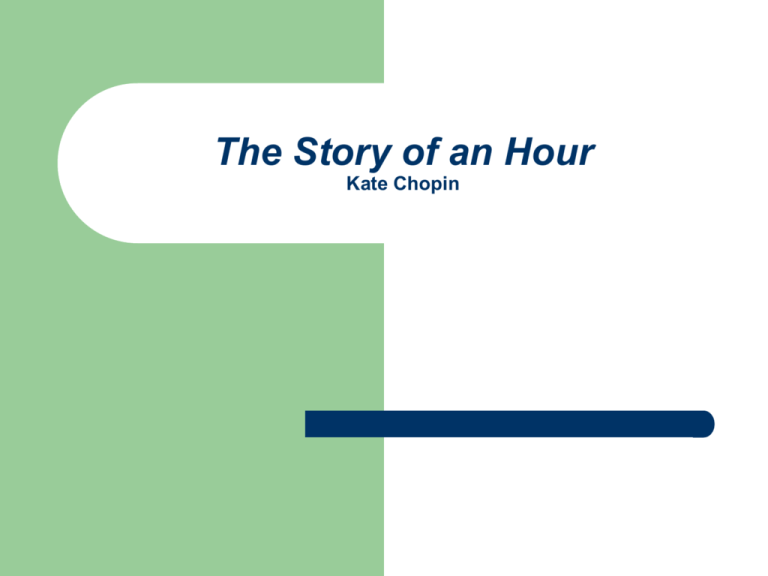The Story of an Hour Kate Chopin
advertisement

The Story of an Hour Kate Chopin Main characters Mrs. Mallard – – Josephine – – Friend to Mrs. Mallard Person who tells of the “disaster” Richards – Wife to Brently Mallard Main character in the story Friend of Brently, who shares in the retelling of the news Brently Mallard – – Husband to Mrs. Mallard According to the reports, dead in a railroad accident Key events in the story: 1. Railroad disaster is reported a. 2. Brently Mallard heads the list of those killed Mrs. Mallard is informed of the news by Josephine and Richards a. Mrs. Mallard weeps at the news and retreats to a “Study” room i. Secretly begins to see the world in a new light “She could see in the open square before her house the tops of trees that were all aquiver with the new spring life. The delicious breath of rain was in the air. In the street below a peddler was crying his wares. The notes of a distant song which someone was singing reached her faintly, and countless sparrows were twittering in the eaves” Storyline…continued a. Mrs. Mallard’s retreat (continued) ii. Physical description of Mrs. Mallard 1. “young, with a fair, calm face…” iii. Mrs. Mallard becomes “free” iv. Knows that she will temporarily weep later at the funeral, but that she will be forever free 1. “Free! Body and soul Free!” v. Josephine is imploring her, in the meantime, to open the door to the study 1. Mrs. Mallard remains secretly joyous 2. When Mrs. Mallard does open the door, she does so as a victorious women Storyline…continued 3. Josephine and Mrs. Mallard begin to leave the apartment a. The door is opening, it is Brently b. He knows not that he is presumed dead c. Mrs. Mallard shrieks at the sight of Brently d. She dies of “a heart disease…a joy that kills” Questions to think about: What is irony and how is it displayed in this story? Why does Kate Chopin continually refer to Mrs. Mallard in the formal sense, not the personal sense as with the other characters? What does Chopin/Mallard mean by “Free, free, free” What is the imagery created by the following phrases? 1. 2. 3. 4. a. b. How do the following examples show the irony created by Chopin in this story? How do the following examples lead the reader in one direction and prepare the reader for the blunt, maybe tragic ending? Example #1 “She did not hear the story as many women have heard the same, with a paralyzed inability to accept its significance. She wept at once, with sudden, wild abandonment, in her sister’s arms. When the storm of grief had spent itself she went away to her room alone. She would have no one follow her.” Example #2 “She could see in the open square before her house the tops of trees that were all aquiver with the new spring life. The delicious breath of rain was in the air. In the street below a peddler was crying his wares. The notes of a distant song which someone was singing reached her faintly, and countless sparrows were twittering in the eaves” Example #3 “When she had abandoned herself, a little whispered word escaped her slightly parted lips. She said it over and over under her breath; ‘Free, Free, Free!’ The vacant stare and the look of terror that had followed it went from her eyes. They stayed keen and bright. Her pulses beat fast, and the coursing blood warmed and relaxed every inch of her body” Example #4 “There would be no one to live for during those coming years; she would live for herself. There would be no powerful will bending hers in that blind persistence with which men and women believe they have a right to impose a private will upon a fellow creature.” Example #5 She arose at length and opened the doors to her sister’s importunities. There was a feverish triumph in her eyes, and she carried herself like a goddess of Victory.”







